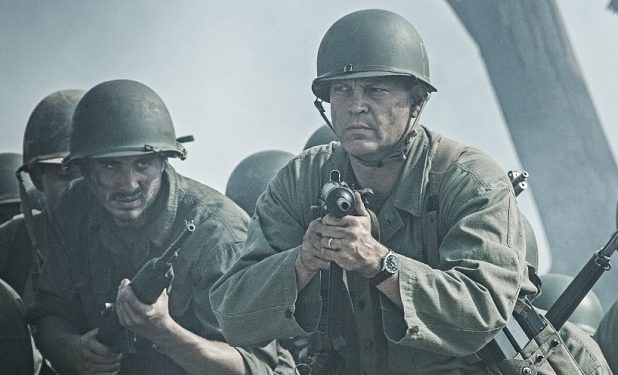Mel Gibson’s new war film “Hacksaw Ridge” is peculiar in the
sense that it’s extremely violent and gory (sometimes relentlessly so) but its
protagonist is curiously nonviolent. Based on a true story, the film revolves
around American Desmond Doss (Andrew Garfield) a World War 2 medic who refused
to kill or even carry a gun but still managed to save over seventy wounded
soldiers.
Otherwise, the picture is a fairly straightforward biopic/
tale of wartime heroics. There aren’t a lot of surprises plot wise. Outside of
the violence, the filmmaking feels very old fashioned. Meanwhile, The battle
sequences are brutal to say the least but also exhilarating and highly
stylized. Gibson wants to emphasize the ugliness of war as well as the glory of
it. There’s nothing necessarily wrong with making war look exciting and
glorious (most war films do, whether intentionally or not) but there are times
when Gibson goes overboard, the violence coming off as cartoonish, which partly
undermines the film’s sincerity.
“Hacksaw Ridge” works best as a character study of its conflicted
hero. What’s most peculiar about Doss is that he wants to join the war effort
but is morally opposed to killing/fighting (arguably the main ingredient of
war) making the film’s stance on war/violence nuanced. On the one hand, war is
such a twisted, ugly thing wherein killing (one of the worst things someone can
do both legally and morally) is normalized. On the other hand, war is often
associated with honor and courage-- putting your life on the line (and putting
aside your normal feelings towards violence/ killing) for the greater good, for
your country. Doss is committed to the war effort in pretty much everyway except putting aside his personal
feelings towards violence. It’s a fascinating dilemma that distinguishes
“Hacksaw Ridge” from other war films.
When Doss arrives at boot camp and refuses to even fire a
rifle at a target his fight to remain in the army begins. The fellow soldiers
and commanders immediately label him a coward. Here, Gibson wisely doesn’t make
Doss into a self-righteous jerk.
Garfield is superb in the role, giving Doss a combination of
noble stubbornness and modesty. Doss will go to jail before he sacrifices his
beliefs but he isn’t arrogant or holier-than-thou. He never tries to impose his
beliefs on others (To his credit, Gibson downplays the religious aspect of
picture, at least for most of the picture) or openly denounces the violence
committed by other soldiers. In fact he sees it as a necessary and unavoidable
component. He believes in war and wants to do his part on the battlefield
(saving lives) but cannot bring himself to personally commit murder. Overall,
Doss is painted as a down to earth man whose beliefs seem to come from a
genuine and humble place.
I do wish Gibson had taken more time to flesh some of the
other soldiers in Doss’s unit, either in boot camp or out on the battlefield
before the action happens. There really aren’t any memorable soldiers outside
of Vince Vaughn as an insult-shouting Sergeant and that’s mainly because he’s
playing against type. There isn’t much to the character. Camaraderie between
soldiers is an important staple of the war picture that’s sorely missed here. It
would have also made Doss’s heroics more impactful later on.
As for the battle scenes themselves…whoa boy. Doss may not
believe in killing or violence but Gibson sure does. Soldiers on both sides are
killed in droves—shot, sliced, stabbed, blown into pieces, burned alive.
Intestines are littered all over the battlefield. At one point, an American
solider uses the upper half of a human torso as a shield to gun down five or
six enemies. The sound design is almost
ear shattering; I could feel my theater seat vibrate multiple times. They’re brutal
and stylish; Gibson uses a lot of slow motion and Rupert Gregson-Williams’
orchestral score is energetic. The battle sequences arouse as much exhilaration
in the viewer as it does discomfort.
Perhaps they arouse too much exhilaration. The violence
becomes more stylized and extreme as the picture goes on to the point of
ridiculousness. At one point, after what feels like a two minute montage of
both US and Japanese soldiers getting killed in excess, I though to myself:
“OK, cool it Mel.” The Japanese soldiers are mostly one-dimensional cartoon
villains; there’s even an ultra stylized Seppuku scene that’s laughable in how
over the top it is. I don’t have a problem with cartoonish violence but in the
context of a sincere biopic/war film it dilutes things a bit.
That being said, despite all the carnage and mayhem, Gibson
never bends the facts and betrays Doss’s character. It would be easy to put him
in a situation where he’s “forced” to pick up a weapon but that would have
dishonored the character and cheapened the film further.
With all the personal stuff that’s plagued Gibson’s career
over the past ten years or so, it’s easy to forget how great an actor he is and
how great a director he is. Though he overdoes the violence a bit, Gibson still
crafts a compelling portrait of an unusual war hero-- motivated by an
obligation to serve his country and an unshakable resistance to violence.
B



No comments:
Post a Comment